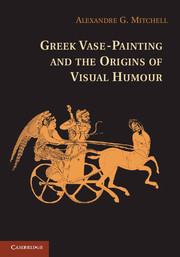Book contents
- Frontmatter
- Epigraph
- Contents
- List of Illustrations
- List of Tables
- Preface
- Acknowledgements
- Abbreviations
- GREEK VASE-PAINTING AND THEORIGINS OF VISUAL HUMOUR
- One Introduction
- Two Humour in the City
- Three Humour in the City
- Four Satyrs and Comic Parody
- Five Caricatures inAthens and at the Kabirion Sanctuary in Boeotia
- Six Conclusion
- Glossary
- Bibliography
- Index of Vases Cited in the Text
- General Index
Two - Humour in the City
The World of Men, Women, and Animals
Published online by Cambridge University Press: 05 January 2014
- Frontmatter
- Epigraph
- Contents
- List of Illustrations
- List of Tables
- Preface
- Acknowledgements
- Abbreviations
- GREEK VASE-PAINTING AND THEORIGINS OF VISUAL HUMOUR
- One Introduction
- Two Humour in the City
- Three Humour in the City
- Four Satyrs and Comic Parody
- Five Caricatures inAthens and at the Kabirion Sanctuary in Boeotia
- Six Conclusion
- Glossary
- Bibliography
- Index of Vases Cited in the Text
- General Index
Summary
This chapter is devoted to the visual mockery of most aspects of everyday life and mythology. According to Diogenes Laertius (1.33), Thales often used to say that he thanked the gods for making him a human not a beast, a man not a woman, and finally a Greek and not a foreigner. I have ordered the chapter accordingly, gradually, starting from the comical use of inanimate objects, animals in situation comedy, social stereotypes and comic archetypes about women, and then moving onto men, finally concluding with debased heroes and gods.
THE COMICAL INANIMATE:VISUAL PUNS AND MISUSED OBJECTS
Eye-cups
Visual humour begins with corrupted eye-cups, a very common series in the sixth century BC. To understand the comic mechanisms of this very ‘inanimate’ type of visual humour, a presentation of the eye-cup series, and a critique of its usual interpretations, apotropaism, and anthropomorphism is in order.
Eye-cups, Augenschale (Steinhart 1995), coupe àà yeux, as a term of classifi cation, is misleading and probably inadequate; a good number of vases of many different shapes, techniques, provenance, and date were decorated with eyes since the seventh century BC. For example, a ‘Melian’ (from Paros) amphora in Athens, produced in the 640s (Papastamos 1970:93), has two eyes under the handles. The latter magnify the eyebrows to create an impression of depth. On a Boeotian krater in Munich, two eyes with arrows as brows are painted under the handles. A Naxian amphora (from Delos) in Mykonos has a large eye under a handle; an Ionian multiple eye bowl (from Naucratis) in London shows two pairs of eyes; and a Rhodian oinochoe in Munich 5 has two eyes painted on either side of the spout. Except for the eyes, they do not have much in common with the Athenian eye-cups, but they demonstrate that eyes on vases have a long tradition.
- Type
- Chapter
- Information
- Greek Vase-Painting and the Origins of Visual Humour , pp. 36 - 94Publisher: Cambridge University PressPrint publication year: 2009



